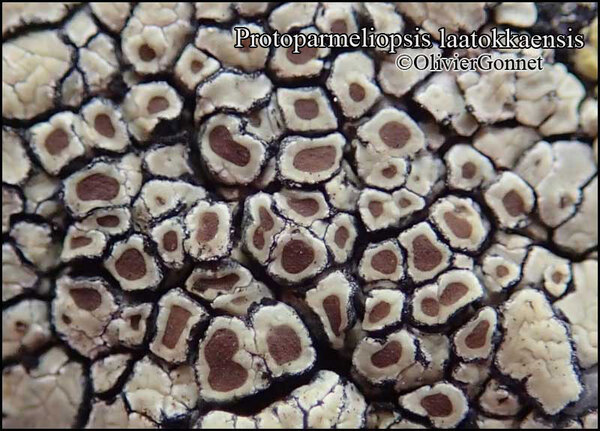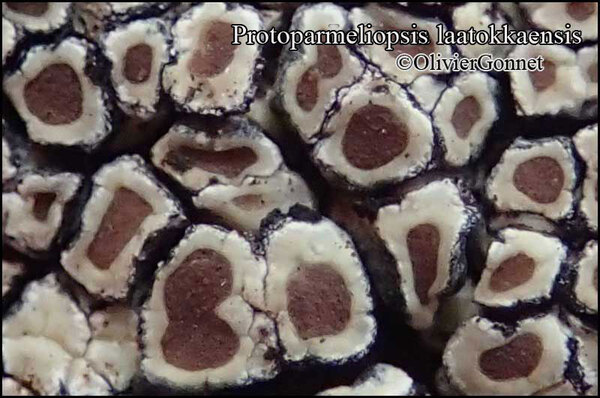Protoparmeliopsis laatokkensis (Räsänen) Moberg & R. Sant.
in Santesson & al., Lichen-forming and lichenicolous fungi of Fennoscandia: 269, 2004. Basionym: Parmularia laatokkensis Räsänen - Ann. Bot. Soc. Zool.-Bot. Fenn. Vanamo, 12, 1: 63, 1939.
Synonyms: Lecanora laatokkensis (Räsänen) Poelt
Distribution: N - TAA (Ryan & Nash 1993), Lig (Ryan & Nash 1993). C - Sar (Rizzi & al. 2011, Giordani & al. 2013). S - Cal (Puntillo 1996), Si.
Description: Thallus crustose, episubstratic, yellowish green, sometimes with a brownish hue, rimose-areolate, 0.3-0.5 mm thick, forming 1-3 cm wide patches, often delimited by a dark prothallus. Areoles more or less, flat, smooth, 0.5-1.5(-3) mm wide, developing on a dark hypothallus, the peripheral ones sometimes slightly elongate, but not forming a clearly placodioid thallus. Cortex poorly developed, brownish in upper part; medulla white, K/I-. Apothecia lecanorine, abundant, 1-3 in the center of the areoles, 0.3-0.7(-1.5) mm across, at first adnate, finally broadly sessile, with a reddish brown to dark brown, mostly flat disc, and an entire, often wavy, persistent thalline margin. Epithecium brown to olive-brown; hymenium colourless, I+ blue; paraphyses coherent, mainly simple or sparingly branched in upper part, the apical cells not strongly swollen; hypothecium colourless. Asci 8-spored, elongate-clavate, very thin-walled, with a K/I+ blue, tall tholus penetrated by a faintly amyloid apical cushion, the wall K/I-, surrounded by a K/I+ blue outer layer, Lecanora-type. Ascospores 1-celled, hyaline, ellipsoid, 9-15 x 4.5-7.5 µm. Pycnidia rare. Conidia thread-like, 25-30 µm long. Photobiont chlorococcoid. Spot tests: thallus K- or K+ pale yellow, C-, KC+ yellow, P-. Chemistry: usnic acid in cortex, plus zeorin, and usually unknown triterpenoids, sometimes with traces of fatty acids.Note: on schist, serpentine, amphibolite, mostly on horizontal faces near the ground, at least when young, parasitic on other crustose lichens. The record from Lombardy by Valcuvia & Delucchi (2001) is dubious.
Growth form: Crustose
Substrata: rocks
Photobiont: green algae other than Trentepohlia
Reproductive strategy: mainly sexual
paras crustose lichens when young
Commonnes-rarity: (info)
Alpine belt: extremely rare
Subalpine belt: very rare
Oromediterranean belt: rare
Montane belt: rare
Submediterranean belt: absent
Padanian area: absent
Humid submediterranean belt: very rare
Humid mediterranean belt: absent
Dry mediterranean belt: absent
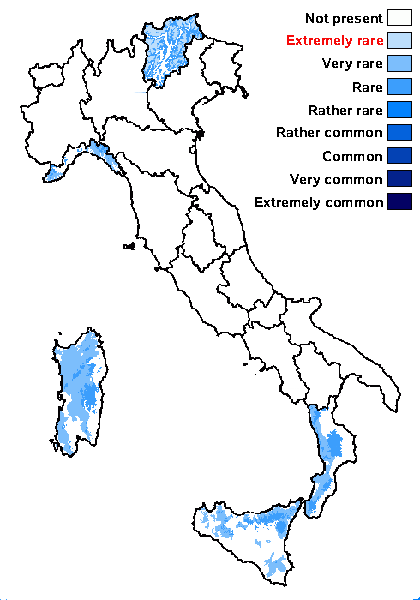
Predictive model
Herbarium samples
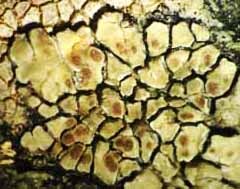
Harrie Sipman – Source http://www.bgbm.fu-berlin.de/sipman/Zschackia/AegeanLichens/CaloplacaAC.htm - As Caloplaca oasis


P.L. Nimis; Owner: Department of Life Sciences, University of Trieste
Herbarium: TSB (6254)
2001/11/25
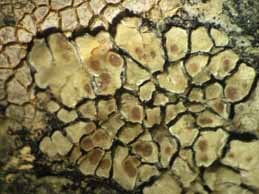
Harrie Sipman – Source http://www.bgbm.fu-berlin.de/sipman/Zschackia/AegeanLichens/CaloplacaAC.htm - As Caloplaca oasis
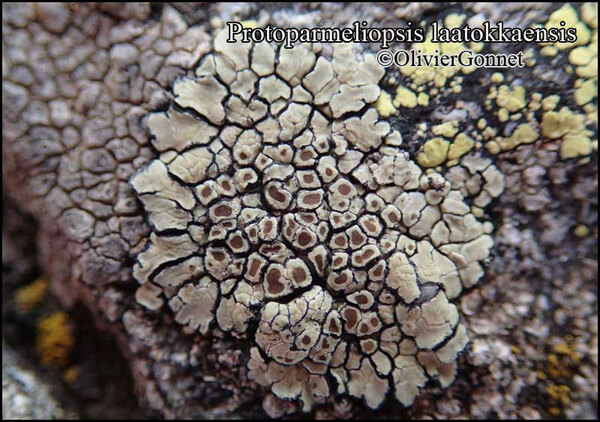
Courtesy Danièle et Olivier Gonnet - Source: https://www.afl-lichenologie.fr/Photos_AFL/Photos_AFL_P/Text_P_3/Protoparmeliopsis_laatokkaensis.htm
France, ession AFL 2014 - Alpes-de-Haute-Provence
Growth form: Crustose
Substrata: rocks
Photobiont: green algae other than Trentepohlia
Reproductive strategy: mainly sexual
paras crustose lichens when young
Commonnes-rarity: (info)
Alpine belt: extremely rare
Subalpine belt: very rare
Oromediterranean belt: rare
Montane belt: rare
Submediterranean belt: absent
Padanian area: absent
Humid submediterranean belt: very rare
Humid mediterranean belt: absent
Dry mediterranean belt: absent

Predictive model
| Herbarium samples |

Harrie Sipman – Source http://www.bgbm.fu-berlin.de/sipman/Zschackia/AegeanLichens/CaloplacaAC.htm - As Caloplaca oasis


P.L. Nimis; Owner: Department of Life Sciences, University of Trieste
Herbarium: TSB (6254)
2001/11/25

Harrie Sipman – Source http://www.bgbm.fu-berlin.de/sipman/Zschackia/AegeanLichens/CaloplacaAC.htm - As Caloplaca oasis

 Index Fungorum
Index Fungorum
 GBIF
GBIF
